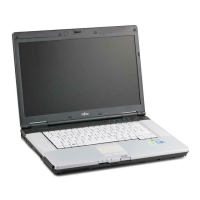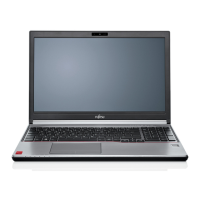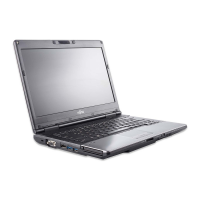How to correct the date and time on a Fujitsu lifebook e746?
- RRichard GarciaSep 2, 2025
You can set the date and time on your Fujitsu Laptop using the BIOS-Setup-Utility in the main menu.

How to correct the date and time on a Fujitsu lifebook e746?
You can set the date and time on your Fujitsu Laptop using the BIOS-Setup-Utility in the main menu.
Why only numerals are written when typing on Fujitsu Laptop?
If when certain characters are entered on the keyboard of your Fujitsu Laptop, only numerals are written, it indicates that the virtual numeric keypad is activated. Press the Num key to deactivate it.
Why is the LCD screen difficult to read on my Fujitsu lifebook e746?
If the LCD screen on your Fujitsu Laptop is difficult to read, it may be due to reflected glare. Try turning the notebook or adjusting the tilt of the LCD screen. Alternatively, increase the brightness of the screen.
What does 'Press to resume, to SETUP' mean on Fujitsu lifebook e746 Laptop?
If your Fujitsu Laptop displays the message 'Press to resume, to SETUP', it indicates an error occurred during the self-test before starting the operating system. Press the F1 function key to start the operating system, or press the F2 key to access the BIOS Setup.
How to resolve Failure Fixed Disk error on Fujitsu lifebook e746 Laptop?
If you encounter a 'Failure Fixed Disk n' error on your Fujitsu Laptop, it means the settings of the hard disk drive are incorrect. Start the BIOS Setup (Primary Master submenu) and select the correct settings.
What does 'nn Stuck key' mean on Fujitsu lifebook e746?
If your Fujitsu Laptop displays 'nn Stuck key', make sure that no key is pressed.
What to do if Fujitsu Laptop LCD screen remains blank?
If your Fujitsu Laptop screen remains blank, try pressing a key or touching the touchpad. If you have an external monitor or television connected, press the key combination to switch the screen output.
What to do if the notebook’s LCD screen remains blank on Fujitsu lifebook e746?
If the LCD screen of your Fujitsu Laptop remains blank, press a key or touch the touchpad to see if the monitor is switched off. If you have an external monitor or television set connected, press the key combination to switch the screen output.
What to do if external monitor is blank or the image is unstable on Fujitsu lifebook e746 Laptop?
If the external monitor is blank or the image is unstable on your Fujitsu Laptop, terminate the application program in Windows by pressing Alt + F4. Set the screen resolution as described in the documentation for your operating system. Select monitor 1 or 2 as described in the documentation for your operating system.
What to do if external monitor is blank on Fujitsu lifebook e746?
If your external monitor remains blank, first ensure it is switched on. If it is on, check if power saving mode has been activated by pressing any key. Adjust the monitor's brightness if it is set too low. Verify that the screen output is correctly set and the power and data cables are properly connected to both the notebook and the monitor. After checking the connections, switch on the external monitor and the notebook.
| Bus type | OPI |
|---|---|
| Stepping | D1 |
| Tjunction | 100 °C |
| Processor cache | 4 MB |
| Processor cores | 2 |
| Processor model | i7-6500U |
| System bus rate | 4 GT/s |
| Processor family | Intel® Core™ i7 |
| Processor series | Intel Core i7-6500 Mobile series |
| Processor socket | LGA 1356 (Socket B2) |
| Processor threads | 4 |
| Processor codename | Skylake |
| Configurable TDP-up | 25 W |
| Processor frequency | 2.5 GHz |
| Processor cache type | Smart Cache |
| Configurable TDP-down | 7.5 W |
| Processor lithography | 14 nm |
| Processor manufacturer | Intel |
| Processor front side bus | - MHz |
| PCI Express slots version | 3.0 |
| Processor boost frequency | 3.1 GHz |
| Processor operating modes | 64-bit |
| ECC supported by processor | No |
| PCI Express configurations | 1x4, 4x1 |
| Thermal Design Power (TDP) | 15 W |
| Configurable TDP-up frequency | 2.6 GHz |
| Configurable TDP-down frequency | 0.8 GHz |
| Maximum number of PCI Express lanes | 12 |
| On-board graphics card | Yes |
| On-board graphics card ID | 1916 |
| Discrete graphics card model | Not available |
| On-board graphics card model | Intel® HD Graphics 520 |
| Maximum on-board graphics card memory | 1.74 GB |
| On-board graphics card OpenGL version | 4.4 |
| On-board graphics card base frequency | 300 MHz |
| On-board graphics card DirectX version | 12.0 |
| On-board graphics card dynamic frequency (max) | 1050 MHz |
| Form factor | Clamshell |
| Product type | Laptop |
| Product color | Gray |
| Memory slots | 2x SO-DIMM |
| Internal memory | 8 GB |
| Memory clock speed | 2133 MHz |
| Memory form factor | SO-DIMM |
| Internal memory type | DDR4-SDRAM |
| Maximum internal memory | 32 GB |
| Memory layout (slots x size) | 1 x 8 GB |
| SSD capacity | The Solid State Drive's storage capacity in Gigabytes. |
| SSD interface | SATA III |
| Storage media | SSD |
| SSD form factor | 2.5\ |
| Total storage capacity | 512 GB |
| Compatible memory cards | SD, SDHC, SDXC |
| Number of SSDs installed | 1 |
| Display surface | Matt |
| Display diagonal | 14 \ |
| Display brightness | 300 cd/m² |
| Contrast ratio (typical) | 700:1 |
| Audio chip | Realtek ALC255 |
| 4G standard | LTE |
| 3G standards | UMTS |
| Wi-Fi standards | 802.11a, Wi-Fi 5 (802.11ac), 802.11b, 802.11g, Wi-Fi 4 (802.11n) |
| Bluetooth version | 4.1 |
| Top Wi-Fi standard | Wi-Fi 5 (802.11ac) |
| Ethernet LAN data rates | 10, 100, 1000 Mbit/s |
| Mobile network generation | 4G |
| Charging port type | DC-in jack |
| USB 2.0 ports quantity | USB 2.0 ports have a data transmission speed of 480 Mbps, and are backwards compatible with USB 1.1 ports. You can connect all kinds of peripheral devices to them. |
| USB 3.2 Gen 1 (3.1 Gen 1) Type-A ports quantity | 3 |
| USB 3.2 Gen 1 (3.1 Gen 1) Type-C ports quantity | 0 |
| Pointing device | Touchpad |
| Battery capacity | 72 Wh |
| Battery life (max) | 14 h |
| Number of battery cells | 6 |
| AC adapter power | 65 W |
| AC adapter frequency | 50 - 60 Hz |
| AC adapter input voltage | 100 - 240 V |
| AC adapter output current | 3.42 A |
| AC adapter output voltage | 19 V |
| Cable lock slot type | Kensington |
| Password protection type | BIOS, HDD, Supervisor, User |
| Operating temperature (T-T) | 5 - 35 °C |
| Operating relative humidity (H-H) | 20 - 80 % |
| Sustainability certificates | RoHS, EPEAT Gold, ENERGY STAR |
| Certification | CE, CB, WEEE, Microsoft Operating Systems (HCT / HCL entry / WHQL) |
| Processor code | SR2EZ |
| Processor ARK ID | 88194 |
| Processor package size | 42 X 24 mm |
| Supported instruction sets | SSE4.1, SSE4.2, AVX 2.0 |
| Intel Secure Key Technology version | 1.00 |
| Intel Stable Image Platform Program (SIPP) version | 0.00 |
| Depth | 231 mm |
|---|---|
| Width | 338 mm |
| Weight | 1700 g |
| Height (rear) | 27 mm |
| Height (front) | 20 mm |
Identifies and explains the ports and controls located on the front of the notebook.
General safety precautions to follow when operating and handling the notebook.
Specific safety guidelines for using integrated wireless LAN and Bluetooth devices.
Steps for safely unpacking the notebook and checking for any transit damage.
Recommendations for choosing a suitable, safe, and ventilated location for device setup.
Instructions on how to correctly connect the AC adapter to power the notebook.
Guide to powering on the notebook for the initial setup and installation process.
Explanation of the various LED indicators and their meanings for system status.
Procedure for powering on the notebook correctly.
Instructions for properly shutting down the notebook to prevent data loss.
Overview of the notebook keyboard layout and key functions.
Guidelines for proper battery charging, maintenance, and storage to maximize lifespan.
Step-by-step instructions for safely removing and installing the notebook battery.
Step-by-step guide for docking the notebook to the port replicator.
Procedure for safely undocking the notebook from the port replicator.
Guidance on setting up BIOS passwords for enhanced system security.
Detailed steps for setting supervisor and user HDD passwords in BIOS.
Instructions for removing existing BIOS supervisor and user HDD passwords.
How to configure password prompts during system startup.
General precautions and safety notes for handling internal components and ESD sensitive devices.
Steps to take before starting any component removal or installation procedure.
Detailed instructions for adding or removing RAM modules.
How to access and start the BIOS Setup Utility program.
Guide to navigating and making changes within the BIOS Setup Utility interface.
Options for saving changes, discarding them, or loading defaults before exiting BIOS.
Procedure to save all BIOS changes and shut down the notebook.
What to do when encountering a problem that cannot be resolved independently.
Steps to diagnose and resolve issues preventing the notebook from starting up.
Solutions for when the notebook unexpectedly stops functioning or freezes.
Overview of procedures for backing up and recovering system images for Windows 7 and 10.
Steps to recover the system when the hard drive is still accessible.
Guide to creating a bootable USB recovery drive for troubleshooting Windows 10.
Overview of available recovery options for Windows 10, such as system restore or PC reset.
Instructions on how to reset the PC, keeping or removing personal files.
Steps to reinstall Windows using a previously created recovery drive.
Guide to reinstalling Windows using external installation media.










